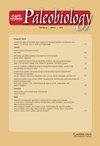Ankylosaurian body armor function and evolution with insights from osteohistology and morphometrics of new specimens from the Late Cretaceous of Antarctica
IF 2.6
2区 地球科学
Q2 BIODIVERSITY CONSERVATION
引用次数: 0
Abstract
The body armor of ankylosaurians is a unique morphological feature among dinosaurs. While ankylosaurian body armor has been studied for decades, paleohistological analyses have only started to uncover the details of its function. Yet there has been an overall bias toward sampling ankylosaurian remains from the Northern Hemisphere, with limited quantitative studies on the morphological and functional evolution of the osteoderms composing their body armor. Here, we describe new ankylosaurian materials recovered from the Late Cretaceous of Antarctica that, in combination with data compiled from the literature, reveal new insights into the evolution of the ankylosaurian body armor. Based on histological microstructure and phylogenetic results, the new Antarctic material can be assigned to Nodosauridae. This group shares the absence/poor development of their osteodermal basal cortex and highly ordered sets of orthogonal structural fibers in the superficial cortex. Our morphospace analyses indicate that large morphological diversity is observed among both nodosaurids and ankylosaurids, but osteoderms became more functionally specialized in late-diverging nodosaurids. Besides acting as effective protection against predation, osteoderms also exhibit highly ordered structural fibers in nodosaurids, enabling a decrease in cortical bone thickness (as in titanosaurs), which could have been co-opted for secondary functions, such as calcium remobilization for physiological balance. The latter may have played a key role in nodosaurid colonization of high-latitude environments, such as Antarctica and the Arctic Circle.从南极晚白垩纪新标本的骨组织学和形态计量学角度分析甲龙的护甲功能和进化
甲龙的身体盔甲是恐龙中一个独特的形态特征。虽然甲龙的身体盔甲已经研究了几十年,但古组织学分析才刚刚开始揭示其功能的细节。然而,人们普遍倾向于从北半球采集甲龙遗骸,对构成其盔甲的骨皮动物的形态和功能进化的定量研究有限。在这里,我们描述了从南极洲白垩纪晚期发现的新的甲龙材料,结合文献中汇编的数据,揭示了对甲龙身体盔甲进化的新见解。根据组织学微观结构和系统发育结果,新的南极材料可以归属于结节龙科。这一组人的骨真皮基底皮层缺失/发育不良,浅皮层中有高度有序的正交结构纤维。我们的形态空间分析表明,在结节龙和甲龙类中都观察到了巨大的形态多样性,但骨皮动物在晚期分化的结节龙类中的功能变得更加特殊。除了对捕食起到有效的保护作用外,结节龙类的骨皮动物还表现出高度有序的结构纤维,使皮质骨厚度减少(如泰坦巨龙),这可能被用于次要功能,如钙再活化以实现生理平衡。后者可能在结节龙类在高纬度环境(如南极洲和北极圈)的殖民化中发挥了关键作用。
本文章由计算机程序翻译,如有差异,请以英文原文为准。
求助全文
约1分钟内获得全文
求助全文
来源期刊

Paleobiology
地学-古生物学
CiteScore
5.30
自引率
3.70%
发文量
38
审稿时长
>12 weeks
期刊介绍:
Paleobiology publishes original contributions of any length (but normally 10-50 manuscript pages) dealing with any aspect of biological paleontology. Emphasis is placed on biological or paleobiological processes and patterns, including macroevolution, extinction, diversification, speciation, functional morphology, bio-geography, phylogeny, paleoecology, molecular paleontology, taphonomy, natural selection and patterns of variation, abundance, and distribution in space and time, among others. Taxonomic papers are welcome if they have significant and broad applications. Papers concerning research on recent organisms and systems are appropriate if they are of particular interest to paleontologists. Papers should typically interest readers from more than one specialty. Proposals for symposium volumes should be discussed in advance with the editors.
 求助内容:
求助内容: 应助结果提醒方式:
应助结果提醒方式:


